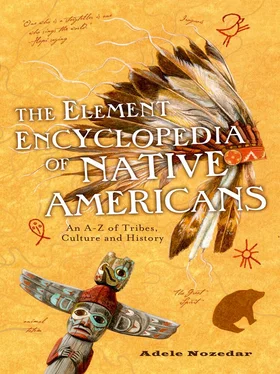1 ...6 7 8 10 11 12 ...30 The Inuitand Aleutpeoples built large lodges in which many people could live; this was the barabara. Partially dug into the ground to a depth of approximately 2 feet, the barabara was lined with timber and the roof—except for a chimney or smokehole—made from arched branches covered over with earth and bark.
An ancient craft, the making of baskets was an essential skill carried out by every Native American people. Materials used for making baskets included grasses and reeds, whippy branches, bark, and roots. The Natives of the Great Lakes favored birch bark containers over baskets, whereas cane and willow were the preferred materials in the south. There were two specific styles of basket which are still made all over the world—woven baskets, and coiled ones. The former took as its basis a framework of a stouter material which would be woven through and in between that framework. Coiled baskets were made from braided material that would be coiled and then stitched into the shape of the basket.
Patterns can be woven into baskets with fibers of contrasting color and texture. Different tribes developed their own unique designs.
As well as being used to carry equipment, food, and other objects, baskets also made handy cooking receptacles. To use a basket in this way the receptacle was first lined with pitch or clay to make it watertight. During the cooking process the clay hardened; afterwards it was discovered that the clay vessel could be used on its own, without needing the basket itself. It’s not unlikely that pottery was developed because of using baskets in this way. However, it was also possible to weave baskets which were in themselves watertight, with no need to use any coating material. To boil something in a basket—which of course could not be used over direct heat—the water inside it was heated by dropping hot stones inside.
Basket-weaving skills were also used to make cradles, shields, fences, boats, and fishing nets, among other objects.
BATTLE OF LITTLE BIG HORN
See Custer’s Last Stand
Blankets were an important resource for the Native Americans, and were made from hair, down, fur, wool, cotton, feathers, and even bark. They were used as clothing, shelter, for making partitions, and even to wrap up goods and carry them while traveling.
The bayeta —Spanish for “baize”—was the best known of all the various types of blankets made by the Navajo. They were generally a subdued reddish color, made from the baize which had been introduced as a trading item in the 19th century. The Navajo unraveled the fabric and reconstituted it into beautiful blankets.
Just about all Native American peoples used beads as decoration. These beads were made from nuts and seeds, wood, bone, horn, shells, teeth, claws, the beaks of birds, and also minerals including turquoise, soapstone, quartz, and other stones. Beads made from the shells of shellfish such as the periwinkle were called wampumand were used as currency.
Beads were used to ornament the hair, were sewn onto clothing, and strung onto sinew to make jewelry. When the white settlers arrived, they introduced glass and ceramic beads to the Indians. Historians are able to determine the age of an item by examining any beads that were a part of it.
The territorial spread of the beaver ranged from west of the Mississippi to south of the Great Lakes.
The beaver was a much loved “brother” to the Native American, honored for its industry and ingenuity. Beavers, like men, were observed to live in “families,” and appeared to have their own language, laws, and a chief, and so they were considered to be the equal of human beings. The beaver was also a useful animal: some tribes ate its meat, and after killing it every single part of the animal was used; nothing was wasted. The teeth—notoriously sharp and able to chisel easily through trees to fell them—were prized as weapons, mounted onto the end of a stick which could be used either as a tool or as a weapon. The beaver skin was used to make bags, pouches, and clothing.
Beavers build ingenious homes for themselves: oval-shaped lodges of which about a third is actually in the water. The rest is coated densely with clay so that it is both airtight and watertight.
Native Americans might catch beavers by cutting holes in the ice and waiting until the animal emerged for air, when the hunter would grasp the animal quickly and kill it cleanly and efficiently.
The white settlers, however, also quickly realized the value of the beaver, and soon established a thriving fur trade with the Natives, which assisted good relations on both sides.
Also called the Tsattine , a word that means “those who live among the beavers.” There were many beaversin what is now northwest Alberta in Canada, especially near the Peace River, whose name in the language of the tribe was the Tsades , meaning “beaver river.” The tribe belonged to the Athapascan language family.
The Beaver, among the hardy Native Americans who lived in subarctic conditions, were seminomadic, moving to follow the hunt. Their prey included not only beavers but moose, caribou, and smaller mammals such as rabbits. The Beaver used hand-made animal “calls” of birch-bark to attract their prey. They also sometimes encountered the buffalo.
The Beaver lived in cone-shaped houses which looked a little like tipis, and when huntingbuilt lean to shelters from whatever materials were at hand. Hunting parties consisted of loose bands of families, each assigned a territory; to follow the hunt the tribe used canoes, toboggans, and snowshoes.
The shamanor medicine manof each band slept with his head toward the west, in order to allow him to speak with the spirits. The other tribal members slept toward the rising sun, facing east. They believed that this direction would help them to dream. The Beaver had a strong belief in guardian spirits, and would mutilate themselves to show grief, using methods of self-harm that ranged from chopping off a joint of a finger to piercing their chests. Their introduction to Christianity absorbed many of their traditional beliefs, and placed the priests in a role very similar to that of the shamen.
Because of the potential for the fur trade in territory that was so rich in beavers, the tribe were among the first of the Athapascans to encounter the Europeans, and in 1799 their chief asked for their own fur-trading post. By 100 years later, the Beaver tribe had handed over vast tracts of their land to the Canadian Government.
“What has passed and cannot be prevented should not be grieved for.”
1770–1846
The last pure-blood chief of the Omahapeople, Big Elk was known to his own people as Ontopanga . Big Elk lived during rapidly changing times, and steered his people through these changes with wisdom and perspicacity. It was not only the white men who posed a threat to the Omaha, but the Sioux. What was out of the chief ‘s control, however, was the devastation caused by European diseases: smallpox, in particular, had a shocking effect on the population of his people, which was reduced from 3,000 in 1780 to 300 in 1802.
Big Elk supported the United States in the War of 1812, hoping that a victory would mean that the Government would help protect the Omaha against the Sioux.
Читать дальше












